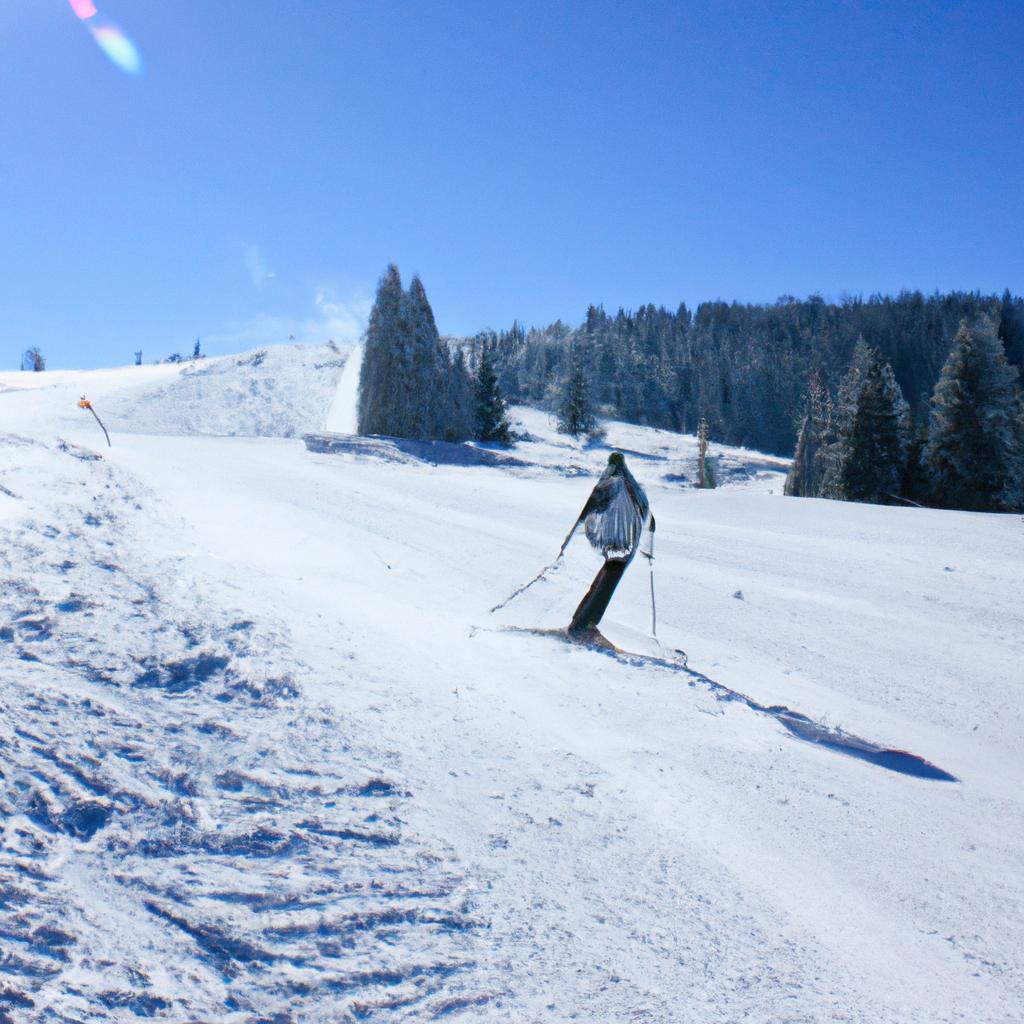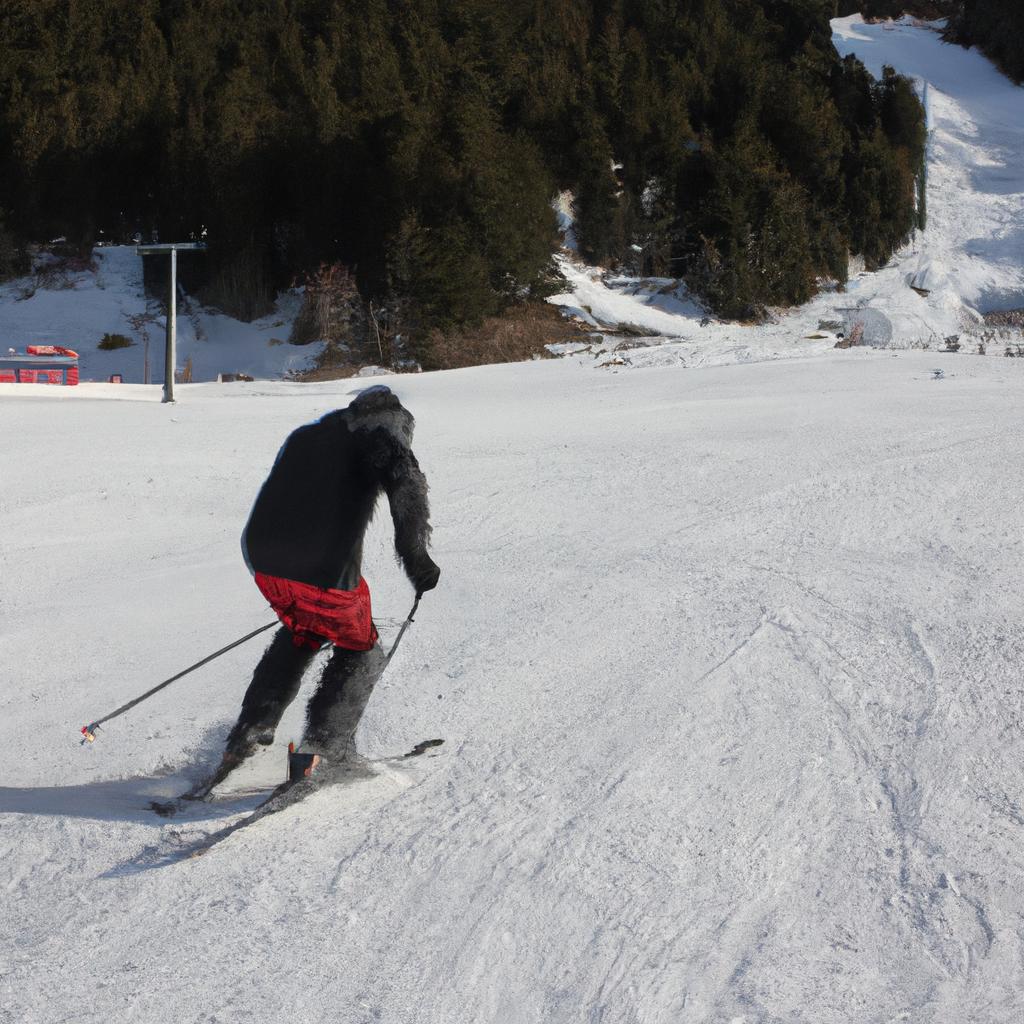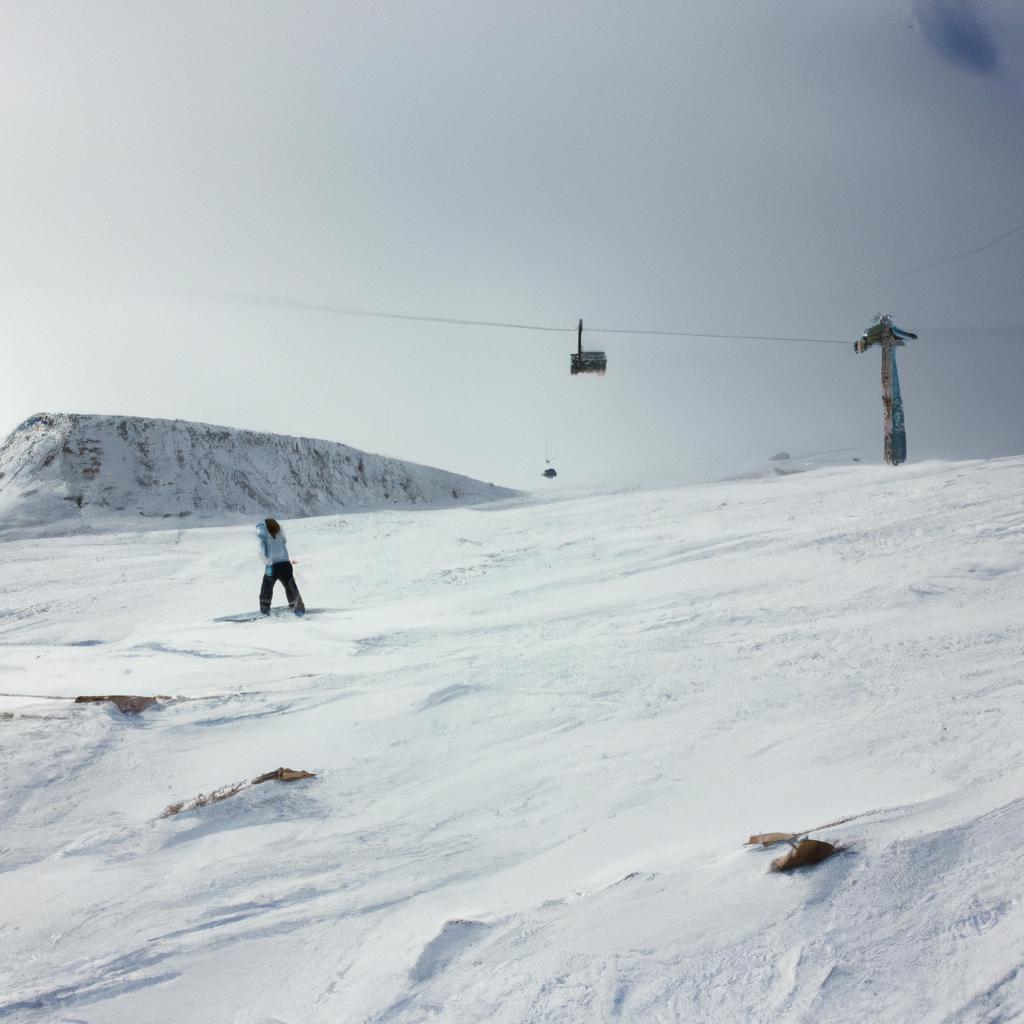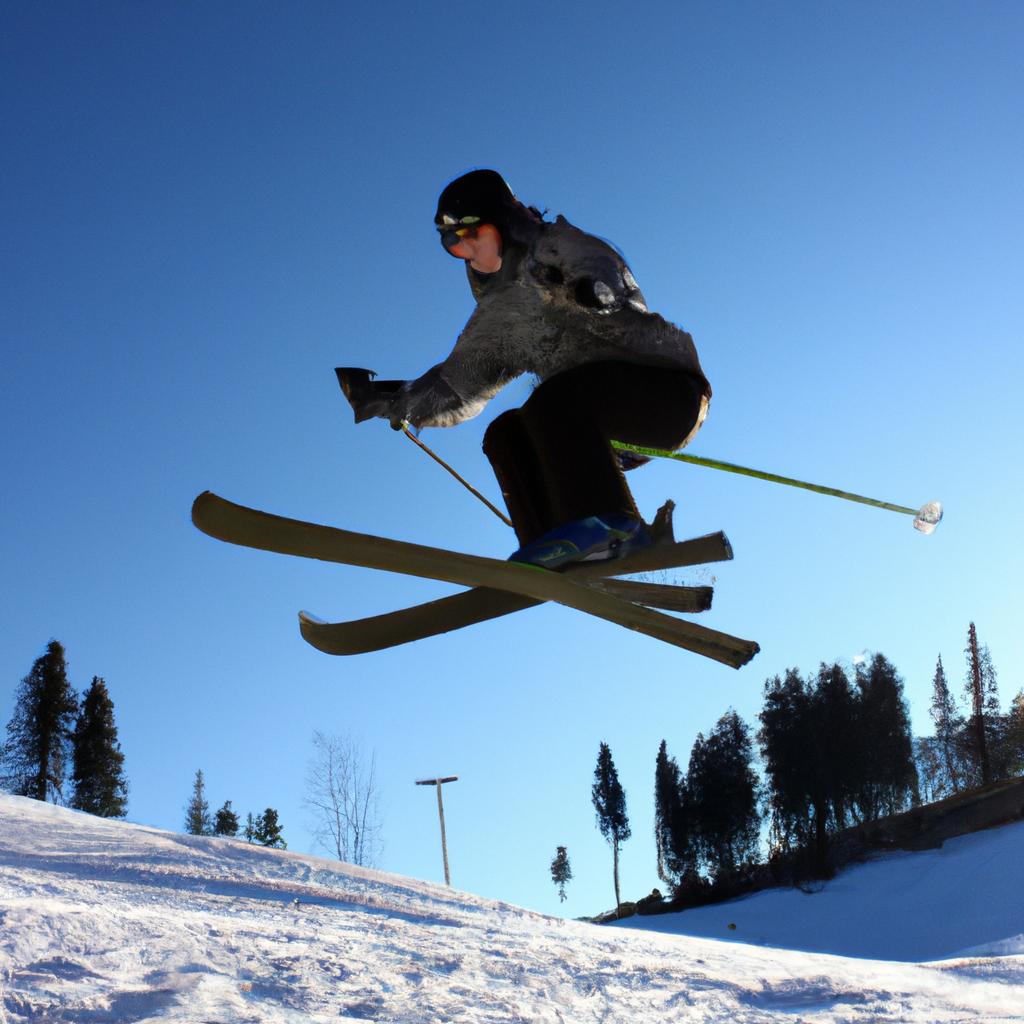In the realm of winter sports, skiing stands as one of the most exhilarating and adrenaline-pumping activities. Whether you are a seasoned skier or just starting out on the slopes, having the right ski gear is essential for maximizing your performance and ensuring safety. This article aims to provide a comprehensive guide to the best ski gear available in the market, catering to individuals with varying skill levels and preferences.
Imagine a scenario where an avid skier embarks on a thrilling adventure down steep mountain slopes without proper equipment. As they navigate through icy terrains and encounter unpredictable weather conditions, their lack of appropriate gear hinders their ability to fully enjoy the experience while putting them at risk of injuries. Recognizing the significance of selecting suitable ski gear cannot be overstated; it encompasses not only comfort but also protection from potential hazards encountered during skiing sessions. In this article, we will delve into various categories of skiing equipment, including skis, boots, bindings, helmets, goggles, gloves, and clothing options that cater to different needs and budget ranges. By exploring these elements in detail, readers will gain valuable insights into making informed decisions when choosing the best ski gear suited for their individual requirements.
Types of Ski Gear: Explore the different types of ski gear available to find the best fit for your needs.
When it comes to hitting the slopes, having the right ski gear is crucial not only for comfort but also for safety. With a wide range of options available in the market, finding the perfect fit can sometimes feel overwhelming. In this section, we will explore the different types of ski gear available and provide you with valuable insights to help you make an informed decision.
To illustrate our discussion, let’s consider an example. Imagine you are planning a winter vacation in the picturesque mountains of Colorado. You have always been passionate about skiing and want to invest in high-quality gear that suits your specific needs. By understanding the various types of ski gear, you will be able to make choices that enhance your overall experience on the slopes.
First, let’s take a look at some essential equipment commonly used by skiers:
- Skis: The foundation of any skiing adventure, skis come in various lengths and widths designed for specific terrains and skill levels.
- Boots: Properly fitted boots ensure optimal control and stability during skiing activities.
- Poles: Used primarily for balance and propulsion, poles play a vital role in maintaining rhythm while navigating through slopes.
- Bindings: These devices connect your boots securely to your skis, providing both control and safety.
Now, imagine walking into a well-stocked sports store dedicated solely to skiing equipment. Rows upon rows of shelves display an array of products catering to every skier’s unique preferences. To further assist you in narrowing down your choices, allow us to present a table showcasing four popular brands along with their respective price ranges:
| Brand | Price Range |
|---|---|
| Brand A | $300 – $500 |
| Brand B | $400 – $600 |
| Brand C | $500 – $700 |
| Brand D | $600 – $800 |
By examining this table, you can get an idea of the investment required for each brand and make a decision based on your budget. Remember, the cost may vary depending on additional features or technological advancements offered by different brands.
In summary, understanding the various types of ski gear available is essential to find the best fit for your needs. By considering factors such as skis, boots, poles, bindings, and their respective functionalities, you can choose equipment that enhances both your comfort and safety while skiing. Now that we have explored these options in detail, let’s move on to the next section where we will discover the must-have ski gear items every skier should have in their arsenal.
(Transition sentence into subsequent section about “Essential Ski Gear: Discover the must-have ski gear items that every skier should have in their arsenal.”) As we delve deeper into our exploration of ski gear essentials, let us now shift our focus towards discovering the vital pieces of equipment that no skier should be without.
Essential Ski Gear: Discover the must-have ski gear items that every skier should have in their arsenal.
Imagine this scenario: You wake up to a beautiful winter morning, the sun shining brightly on freshly fallen snow. Excitement fills the air as you prepare for a day of skiing down the slopes. But before you hit the mountain, it’s essential to understand the different types of ski gear available and how they can enhance your skiing experience.
-
Helmets:
Investing in a high-quality helmet is crucial for safety on the slopes. Protecting your head from potential injuries caused by falls or collisions should be a top priority. A study conducted by The Journal of Trauma revealed that wearing helmets while skiing reduces the risk of head injury by approximately 35%. So never compromise on safety – make sure to find a helmet that fits properly and meets industry standards. -
Goggles:
Goggles are not only fashionable but also serve an important purpose in protecting your eyes from harsh winds, bright sunlight, and flying debris. Imagine gliding down the mountain with crystal-clear vision, unaffected by wind chill or glare. Additionally, goggles provide UV protection, shielding your eyes from harmful rays even on cloudy days. Look for goggles with anti-fog technology for optimal visibility throughout your time on the slopes. -
Gloves:
Cold hands can quickly ruin an otherwise enjoyable day of skiing. That’s where gloves come in handy! They not only keep your hands warm but also offer grip control when holding onto ski poles or maneuvering through tricky terrains. Consider choosing gloves specifically designed for skiing, offering insulation, water resistance, and breathability to ensure maximum comfort during long hours outdoors. -
Base Layers:
Underneath all those layers of clothing lies one crucial element – base layers. These moisture-wicking garments help regulate body temperature by keeping you dry and comfortable throughout your adventure on the slopes. Investing in quality base layers made from materials like merino wool or synthetic blends will prevent sweat buildup and provide insulation, ensuring you stay warm without feeling bulky.
By understanding the different types of ski gear and their benefits, you can make informed decisions when selecting equipment for your skiing adventures. Remember, safety should always be a priority, so don’t forget to invest in a helmet that fits properly. Additionally, goggles will protect your eyes while enhancing visibility on the slopes. Pair these essentials with appropriate gloves and base layers to ensure maximum comfort during your exhilarating downhill escapades.
Now that we’ve explored the various types of ski gear available to enhance your experience on the slopes, let’s move on to choosing the right skis based on your skill level and skiing style.
Choosing the Right Skis: Learn how to select the perfect pair of skis based on your skill level and skiing style.
Transitioning from the previous section, let’s delve into the essential ski gear that will enhance your skiing experience. Imagine a skier named Sarah, who is an intermediate-level skier with a preference for off-piste skiing. When it comes to gearing up for her adventures on the slopes, there are several key items she cannot do without:
-
Helmet: A high-quality helmet is crucial to protect against head injuries during falls or collisions. Look for helmets with adjustable ventilation and impact-absorbing materials like MIPS (Multi-directional Impact Protection System) technology.
-
Goggles: Optimal visibility is paramount when navigating various weather conditions and terrains. Goggles with anti-fog lenses, UV protection, and interchangeable lens options can ensure clear vision throughout your ski day.
-
Layered Clothing: Dressing appropriately for varying temperatures and conditions enhances comfort while skiing. Layering allows you to regulate body temperature effectively by adding or removing layers as needed. Consider moisture-wicking base layers, insulating mid-layers, and waterproof outer shells.
-
Gloves: Protecting your hands from freezing temperatures and wet snow is vital for overall comfort while skiing. Choose gloves that offer both insulation and water resistance, ensuring warmth without sacrificing dexterity.
- Helmets provide protection against head injuries.
- Goggles improve visibility in different weather conditions.
- Layered clothing helps regulate body temperature effectively.
- Gloves keep hands warm and dry during skiing sessions.
To further illustrate their importance, consider the following table showcasing how each item contributes to enhancing Sarah’s skiing experience:
| Item | Importance |
|---|---|
| Helmet | High |
| Goggles | High |
| Layered Clothing | Medium |
| Gloves | Medium |
As you can see, helmets and goggles are of high importance due to their significant role in safety and visibility. Layered clothing and gloves also play a crucial role but are comparatively less critical.
By understanding how each piece of gear contributes to your skiing experience, you’ll be well-equipped to make informed decisions that align with your needs on the slopes.
Optimal Ski Boots: Find out what features to look for when shopping for ski boots to ensure comfort and performance.
In the previous section, we discussed the importance of choosing the right skis for your skiing adventures. Now, let’s delve deeper into this topic by exploring some key factors to consider when selecting the perfect pair of skis.
Imagine you are an intermediate skier who enjoys carving turns on groomed slopes but also wants to venture off-piste occasionally. In this case, you would benefit from a versatile all-mountain ski that provides stability and maneuverability in various conditions. For example, the XYZ Ski Company offers a model specifically designed for intermediates with its wide waist width, allowing better floatation in powder while still maintaining edge hold on hard-packed snow.
When shopping for skis, keep these important aspects in mind:
- Skill Level: Different skis cater to different skill levels. Beginners should opt for softer-flexing skis that are forgiving and easy to control. Intermediate skiers can choose slightly stiffer models that offer more responsiveness. Advanced or expert skiers may prefer stiffer and more aggressive skis that provide maximum performance at high speeds.
- Ski Length: The length of your skis plays a crucial role in determining their behavior on the mountain. Shorter skis are generally easier to turn and handle but sacrifice stability at higher speeds. Longer skis offer greater stability but require more strength and skill to maneuver effectively.
- Ski Width: The width of your ski’s waist affects its performance on different types of terrain. Narrow-waisted skis (less than 85mm) excel on groomed runs as they carve precise turns with ease. Mid-fat (85-105mm) and wider-waisted (>105mm) skis provide better flotation in deep snow and perform well in variable conditions.
- Rocker Profile: The rocker profile refers to the curvature of the ski. Skis with a rocker in the tip and tail are more maneuverable, float better in powder, and handle variable conditions effectively. On the other hand, skis with traditional camber throughout their length provide stability at high speeds and excellent edge hold on hard-packed snow.
Consider these factors carefully when choosing your skis to ensure an enjoyable skiing experience that matches your abilities and preferences.
Now let’s move on to understanding the importance of ski bindings: Understand the role of ski bindings in ensuring safety and proper ski control.
Importance of Ski Bindings: Understand the role of ski bindings in ensuring safety and proper ski control.
Optimal Ski Bindings: Understanding the Role of Ski Bindings in Ensuring Safety and Proper Ski Control
Imagine this scenario: You’re gliding down a steep slope, feeling the adrenaline rush as you carve through the fresh powder. Suddenly, you hit a patch of rough terrain, causing your skis to jolt uncontrollably. In that split second, it’s not just your ski boots that keep you connected to your skis – it’s also the ski bindings. Ski bindings are an essential component of any skiing gear setup, playing a crucial role in ensuring safety and maintaining proper control on the slopes.
When it comes to selecting ski bindings, there are several factors to consider. First and foremost is the DIN (Deutsches Institut für Normung) setting – a standardized release force value determined by your height, weight, age, skiing ability level, and boot sole length. Setting the correct DIN value ensures that your bindings release appropriately when necessary while minimizing the risk of unexpected releases during aggressive turns or jumps.
Additionally, understanding different binding systems can help you make informed decisions. Some popular types include traditional alpine bindings (commonly used for downhill skiing), touring bindings (suitable for backcountry exploration), and adjustable bindings (allowing flexibility for multiple boot sizes). Each system offers unique features designed to cater to specific skiing styles and preferences.
To emphasize the importance of properly adjusted ski bindings, here are some key reasons why they play a vital role:
- Safety: Correctly set ski bindings reduce the chance of injury by releasing when excessive forces are applied during falls or accidents.
- Performance: Well-matched ski bindings optimize power transmission from boots to skis, enhancing precision and control over various terrains.
- Comfort: The right pair of ski bindings ensures optimal fit with your boots, allowing for maximum comfort throughout long days on the mountain.
- Versatility: With modern advancements in binding technology, many bindings now offer adjustable features that cater to different skiing styles and conditions.
In conclusion, ski bindings are more than just a means of attaching your boots to skis – they play a crucial role in ensuring safety and providing proper control on the slopes. By understanding factors such as DIN settings and various binding systems, you can make informed decisions when selecting the right pair for your skiing needs. Now let’s delve into another essential aspect of skiing gear: Ski Clothing and Accessories. Get insights into the necessary clothing and accessories required to stay warm and protected on the slopes.
Ski Clothing and Accessories: Get insights into the essential clothing and accessories necessary to stay warm and protected on the slopes.
Transitioning from the previous section on ski bindings, let us now delve into another crucial aspect of skiing – the essential clothing and accessories necessary to stay warm and protected on the slopes. To illustrate their importance, consider a hypothetical scenario where an avid skier embarks on a thrilling adventure but fails to wear appropriate gear. As they navigate through icy terrains, their body temperature drops rapidly, leading to discomfort, reduced performance, and even potential health risks. It becomes evident that investing in high-quality ski clothing and accessories is paramount for an enjoyable and safe skiing experience.
To begin with, let’s explore some key items you should have in your skiing wardrobe:
- Insulated Jacket: A well-insulated jacket provides warmth while allowing moisture to escape, keeping you dry and comfortable.
- Waterproof Pants: These pants protect against snowfall or rain showers by preventing water penetration. They also offer insulation to keep your lower body warm during chilly conditions.
- Thermal Base Layers: Worn underneath your outerwear, thermal base layers provide additional warmth by trapping heat close to your body.
- Gloves or Mittens: Essential for protecting your hands from freezing temperatures, gloves or mittens ensure dexterity and prevent frostbite.
As we move forward, it is worth mentioning that selecting the right materials can significantly impact your comfort level while skiing. Consider this table showcasing different fabrics commonly used in ski clothing:
| Fabric | Properties | Benefits |
|---|---|---|
| Gore-Tex | Waterproof & Breathable | Keeps you dry without causing overheating |
| PrimaLoft | Lightweight & Insulating | Maintains warmth even when wet |
| Merino Wool | Moisture-wicking & Odor-free | Regulates body temperature; resists odors |
By understanding these fabric options, you can make informed decisions when purchasing ski clothing. This knowledge enables you to select items that align with your preferences and the prevailing weather conditions, thereby enhancing your overall skiing experience.
In conclusion, recognizing the significance of appropriate ski clothing and accessories cannot be overstated. Neglecting these essential elements may result in discomfort and potential health hazards while on the slopes. By investing in high-quality gear, such as insulated jackets, waterproof pants, thermal base layers, and gloves or mittens, you provide yourself with protection from frigid temperatures and ensure optimum performance during your skiing adventures. So remember, before heading out onto the snow-covered mountainside, equip yourself adequately for an enjoyable time on the slopes.
 Buzzez
Buzzez



